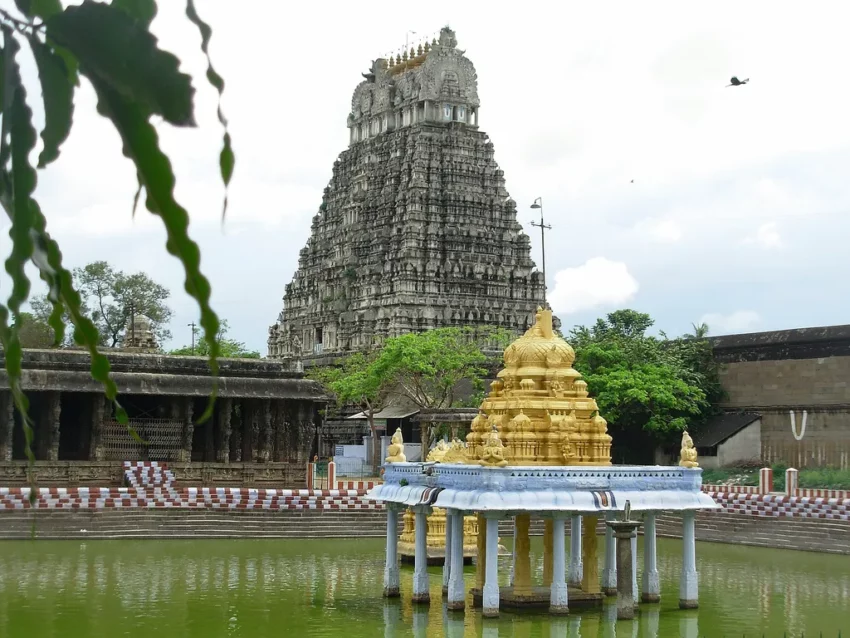The Chayavaneswarar Temple Sayavanam is a Hindu temple dedicated to Lord Shiva, located in the village of Sayavanam in Tamil Nadu, India. This ancient temple, rich in history and tradition, is a significant example of Dravidian architecture. It stands as a testament to the religious devotion and artistic skill of the Tamil people. The temple is renowned for its intricate carvings, towering gopuram (gateway tower), and the sacred tank believed to have curative properties. It has been an important pilgrimage site for centuries and continues to attract devotees and history enthusiasts alike.
Get your dose of History via Email
Historical Background of Chayavaneswarar Temple Sayavanam
The Chayavaneswarar Temple Sayavanam dates back to the Chola dynasty, a period known for temple-building activities. The exact date of its construction remains unclear, but it is believed to have been built during the early medieval period. The temple has undergone several renovations and expansions over the centuries. It has been mentioned in the hymns of Saivite saints, indicating its significance in Tamil religious history.
According to legend, the temple was built by a Chola king after a divine revelation. The king, suffering from leprosy, was instructed by Lord Shiva in a dream to build a temple at this location. Upon completion, the king bathed in the temple’s tank and was miraculously cured. This story contributes to the temple’s reputation as a place of healing.
Over time, the temple has seen various patrons who have contributed to its upkeep and renovation. Notably, the Vijayanagar Empire and local chieftains have played significant roles in its history. The temple has been a center of Shaivism, attracting devotees from far and wide to worship Lord Shiva.
While the temple has not been the scene of major historical events, it has been an integral part of the local community’s spiritual life. It has witnessed countless festivals and rituals, serving as a focal point for religious and social gatherings. The temple’s architecture and inscriptions provide valuable insights into the region’s history and culture.
The Chayavaneswarar Temple Sayavanam continues to be an active place of worship. It stands as a symbol of the enduring legacy of the Chola dynasty and the timeless nature of Tamil religious practices. The temple’s history is a blend of myth, religion, and artistry, making it a fascinating subject for historians and devotees alike.
About Chayavaneswarar Temple Sayavanam
The Chayavaneswarar Temple Sayavanam is a stunning example of Dravidian architecture, characterized by its grand gopuram and intricate stone carvings. The temple complex includes the main shrine, a sacred tank, and several smaller shrines dedicated to various deities. The main deity, Lord Shiva, is worshipped in the form of a lingam, a symbol of divine energy.
The temple’s construction showcases the use of granite, a common building material in South Indian temples. The artisans of the time employed advanced stone-carving techniques to create elaborate sculptures and reliefs. These depict scenes from Hindu mythology, adding to the temple’s spiritual ambiance.
Architectural highlights include the pillared halls, or mandapas, which feature columns with detailed carvings of gods, goddesses, and mythical creatures. The temple’s vimana, the tower above the main shrine, is adorned with ornate sculptures that are typical of Chola artistry. The temple’s layout follows traditional Vastu Shastra principles, aligning the structure with cosmic forces.
The sacred tank, known as the temple tank, is believed to have healing properties. Devotees often take a dip in its waters, seeking physical and spiritual purification. The tank is an integral part of the temple’s identity and plays a key role in various rituals and festivals.
Despite the ravages of time, the Chayavaneswarar Temple Sayavanam has been well-preserved, thanks to the efforts of the local community and heritage conservationists. The temple not only serves as a place of worship but also as a cultural heritage site that attracts tourists and scholars interested in South Indian temple architecture.
Theories and Interpretations
The Chayavaneswarar Temple Sayavanam, like many ancient structures, is shrouded in mystery and lore. One theory suggests that the temple’s location was chosen due to its spiritual significance, believed to be a spot of high energy. The temple’s design and orientation are thought to harness this energy, enhancing the spiritual experience of devotees.
Another interpretation relates to the temple’s healing tank. Some believe that the water’s curative properties are due to natural minerals, while others attribute it to divine intervention. The tank’s significance is a blend of science and faith, with both aspects contributing to its reputation.
The temple’s carvings and inscriptions have been matched to historical records, providing insights into the socio-political climate of the time. These artworks are not only religious expressions but also historical documents that offer a glimpse into the lives of the people who created them.
Dating the temple has been a challenge for historians and archaeologists. While the style of architecture and inscriptions point to the Chola period, precise dating methods like carbon dating have not been extensively applied. The temple’s renovations over the centuries have also made it difficult to determine its exact age.
The temple’s role in the community has evolved over time. Initially a spiritual center, it has become a symbol of Tamil heritage and identity. Theories about its origins and functions continue to be a topic of research and debate among scholars, adding layers of interpretation to its history.
At a glance
- Country: India
- Civilization: Chola Dynasty
- Age: Early medieval period (specific dates unclear)
Image credit: https://www.templefolks.com/temple-pedia/sayavanam-chayavaneswarar-temple

